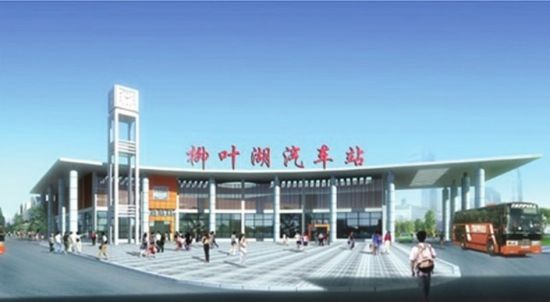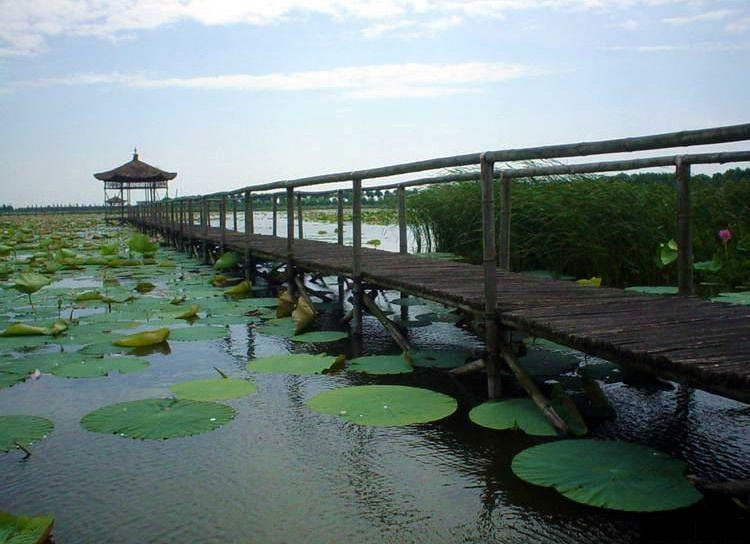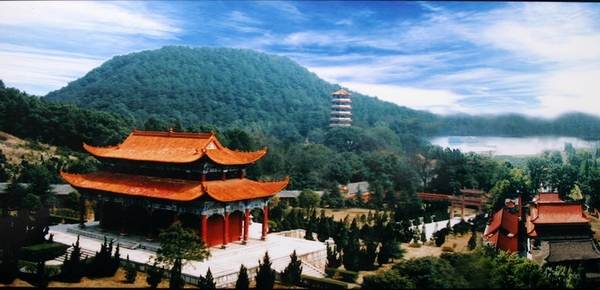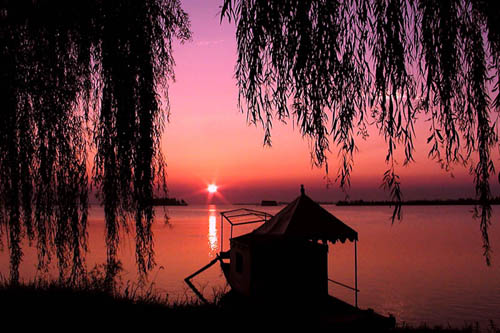-

The construction of Liuye Lake Bus Station began in 2008, and it went into service in September 2009. Adjacent to the Liuye Lake and National Highway 207, it is a first-class bus station covering an area of about 50 mu with a total investment of 40 million Yuan. There are supermarket, a passenger lounge, a smoking room, drinking fountains, WC and a large TV screen for passengers to enjoy. Additionally, to offer more convenience to passengers, there is also a place for you to keep your small articles, as well as easy-access facilities for the disabled. The Bus Station, comprising 28 routes, enables you to get to 2 provinces, 3 cities and 10 counties. Each day, 531 buses meet the average transportation capacity of 10,000 people.
Changde & Yueyang & Hengyang
2010-03-15 19:35
View:3735
-

Xidongting Wetland is located in the eastern part of Hanshou County, Hunan Province. It covers an area of 35,680 hectares and it is the entrance to the Dongting Lake, China’s second largest freshwater lake. It is the bridgehead of the golden tourist route of Changsha-Zhangjiajie, only a hundred kilometers east of Changsha, 40 km west of Changde, and about two-hours drive from Zhangjiajie. In 1998, as approved by the Hunan Provincial Government, it was established as a provincial nature reserve. In 2002, it was included by UNESCO on the “List of 30 Wetlands of International Importance”. In 2005, it was designated by the National Ministry of Construction as one of 9 National City Wetland Parks. In 2008, it was granted the title of National AAA Scenic Spot by the National Tourism Bureau. Xidongting Wetland is like a natural maze. There are abundant waterways and various islands with endless reeds together with a rich production of fish and rice. It is also known as a biological gene bank because it is the habitat for 416 different wet plants, 217 species of birds, and 118 species of fish. It also boasts a profound cultural influence as it is the birthplace of the Canglang Culture. Qu Yuan, the ancestor of Chinese Yongwu Poetry, once lived here and created many verses to honour the Dongting Lake, as did other men of letters, providing many local legends and a rich local mythology. Within the wetland there are more than 30 eco-tourism attractions and 4 cultural spots. It is becoming ever more popular among tourist agencies and travelers alike. The Changsha-Zhangjiajie Expressway passes through this area with two exits at Junshanpu and Taizimiao. There is a county level railway station at Taizimiao on the Shimen-Changsha Railway. The No.319 National Highway and S205 Provincial Highway run through this area eastward and southward respectively. It is also within easy reach of the Huanghua International Airport (1 hour away) and the Taohuayuan Airport (40 minutes away). It provides waterway transportation which can reach many other places via the Dongting Lake.
Changde & Yueyang & Hengyang
2010-03-13 19:50
View:5079
-

The Jiashan Mountain Scenic Area stands in Jinshi County located in the Northwest of Hunan Province. It consists of 4 sections, namely, Jiashan Mountain, Xujia Lake, Shiling-Qingshan Scenic Area and Gucheng Scenic Tourism Town, covering an area of 17.35 km2. As the core scenic spot, Jiashan Mountain is located at the edge of the Wuling Range, with the Dongting Lake to the East, Li River to the West and an idyllic countryside area to the South. Jiashan Mountain occupies an area of 2 km2 with a height of 147.07m. About 0.5 km South of Jiashan Mountain lies the birthplace of Mengjiangnv. According to accounts in the “Story of Mengjiang Mountian” written by Quo Qing in 1867 (the sixth year of Emperor Tongzhi’s reign), Jiashan Mountain was called Cuilu before the Qin Dynasty. After a long trek searching for her husband (Fan Xi), Mengjiangnv failed and cried at the Great Wall. The Great Wall collapsed before her and Meng recognised her husband’s skeleton by shedding her blood. She decided to return to their hometown with the bones but died at Tongguan, Shanxi. The local residents were so moved by her story that they decided to rename their town Mengjiang Mountain, commonly known as Mengjia Mountain. During the period of Emperor Hongzhi in the Ming Dynasty (1488-1505), Li Rugui, the minister of two major departments at that time, was a Lizhou local. Mengjia Mountain was renamed Jiashan Mountain (the Chinese character Jia means “to praise”) by Li Rugui to honour Mengjiangnv. Jiangnv Temple, or Jiangnv Shrine, was built there by other people. It consists of more than 30 houses, with an Entrance Hall, Main Hall, Back Hall and Temple Hall. The Temple experienced destruction and underwent reconstruction many times. In January, 1954, it was laid in ruin after a fierce fire. In the front of the Temple, there was ‘Wangfu Platform’ (a platform used to long for Meng’s husband) and a ‘Mirror Stone’. The well on the Southern slope of Jiashan Mountain is also famed to be a spectacular scene, having existed for a thousand years with constant fresh water. It is said to be the place where Mengjiangnv was bathing as Fan Xi hid behind a tree and peeked at her, after which they became married. This well was thus named the ‘Bathing Well’. Legend has it that lovers can be blessed and have children if they drink water from it. Jiashan lies between Changsha and Wuhan and thus enjoys a unique advantage in terms of transportation links. The Xiangbei Expressway and Taiyuan-Macau Expressway (to be constructed) pass through Jinshi County. It connects the Shimen-Changsha Railway and Zhicheng-Liuzhou Railway. Taohuayuan Airport is also only 80 km away from Jinshi City. Near the city is the Li River, which runs eastward to the Dongting Lake and boasts one of the six major ports of Hunan Province. It is navigable for 500-ton vessels all year round to places as far as Changsha, Wuhan, and Shanghai.
Changde & Yueyang & Hengyang
2010-03-12 20:05
View:4066
-

Liuye Lake Resort lies in the northeastern corner of Changde City proper. It is a harmonious integration of lake, city as well as hills. It has a planning area of 175 km2, in which water area occupies 21.8 km2. It is one of the largest city lakes in China. In ancient times, the belt-shaped lake was well-known for its beautiful scenery with the “willows on the bank swaying in the wind, songs of fishermen spreading from the boats on the lake, pine trees singing in the gentle breeze, and the lake framing a belt of water.” At present, it is recognized as “A Jewel of Hunan”, and “The Best Wonder of Changde”. It is also one of the “Best Natural Aquatic Sports Fields”, as wells as an “Urban Aquatic Paradise”. In 2001, the Liuye Lake was officially recognised as a national AAA tourism spot; in 2006, it was selected as one of the “New Top Eight Scenic Spots of Hunan”. After its construction, it hosted a series of important sports events, including: The Aquatic Sports Events of the Eighth Sports Meeting of Hunan Province, the Eighth Asian Kayak Championship, the All-Star Chinese and American Water Skiing Competition, and the First Short Track Rally of China, etc. Within the resort there are Baihe Hill, Huashan Hill, and Taiyang Hill, all covered with pine and fir trees, and islands in the lake shimmering like emeralds in blue water. Also, Yinyuan Garden, Wujianping Terrace and Mount Zhangjia, a graveyard since the Warring States Period, add a rich cultural atmosphere to the natural scenery. It enjoys convenient transportation links, only 10 km away from Taohuayuan Airport and a 10-minute drive from the downtown area from where tourists can reach all parts of China by train or bus.
Changde & Yueyang & Hengyang
2010-03-11 20:06
View:4772
-

Reshi Hot Spring Resort lies in Reshi Town, Taoyuan County. It boasts 5 hot springs with a temperature of 47℃, the amount of flowing water being 0.5 m3 per second, and 1,800 m3 per hour. The spring water is of a high-quality calcium metasilicate type and contains various useful microelements like bromium, iodium, radium, etc. It meets the No. GB8537-87 State Standard for safe drinking water and is good for bathing. In this resort there is Xingdeshan Mountain, which is a Provincial Key Cultural Relics Protection Unit. It boasts a marvelous natural beauty and profound culture. The elevation of its major peak reaches 843.5 meters at the summit. The tectonic setting is of the Danxia Landform with a bright red colour, which makes for a glorious lustre. The neighbouring regions are of typical karst topography, silver in colour and shaped like bamboo nodes. Between the mountain peaks, there are mysterious canyons and gigantic old trees. It is noted for its Taoist culture, with the ancient Xingzi Palace, having a 638-year history, standing at the top of grotesque and fantastic stone peaks. Xingzi Palace is made of stones, and has a unique architectural style, built by delicate carving skills and fine craftsmanship. There are altogether 72 scenic spots in Xingdeshan Mountain, which is a good place for climbing, worshiping, and sightseeing. It enjoys convenient transportation links, 50 km away from Taohuayuan Airport to the South, 104 km away from the Hehua Airport in Zhangjiajie to the north, and 35 km away from Shimen Railway Station to the east. The Changde-Zhangjiajie Expressway and No. 306 Provincial Highway pass through it.
Changde & Yueyang & Hengyang
2010-03-09 20:07
View:3889









